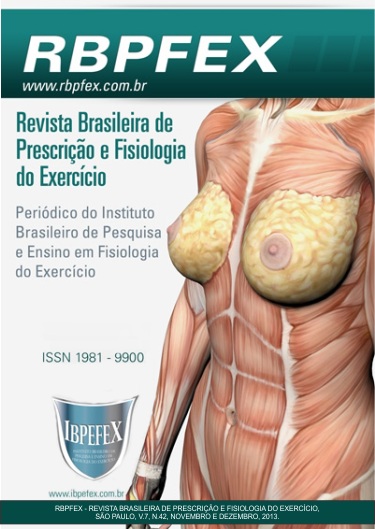Lactate analysis in two sessions of prescribed long-distance running throught heart rate deflection point
Abstract
Introduction: The long-distance running is receiving great dedication from the sport’s researchers regarding increasing performance therefore severalphysiological variables are important for it. Objective: The aim of this study was to analyze the heart rate deflection point, by the visual method which can be an efficient instrument for continuous aerobic training prescription. Materials and Methods: Ten (n = 10) runners (29.5 ± 6.4 years) took the test incremental test intermittent running from which was identified the HRDP for the prescription of two 30-minute workouts: a workout 10% below the HRDP, called subthreshold, and another 10% above, called suprathresh¬old. We used the statistical package SPSS 18.0 for data processing. Results: The lactate concentration during the subthreshold, as much in half time workout (3.85 mmol / L) as at the end (3.68 mmol / L) were significantly lower than the suprathresh¬old (p=0,001), which was 6.31 mmol / L in the minute fifteen, and 7 mmol / L at the end. Discussion: The Shapir-Wilk test shown that both concentration of the suprathresh¬old workout were significantly superior p <0.05 than the values of the subthreshold. In the subthreshold workout both values were below 4 mmol / L, confirming the literature as being a predominantly aerobic exercise. For the suprathresh¬old, there was no stability of this metabolite, which agrees from the literature for a workout of that intensity. Conclusion: These data suggest that HRDP may be an interesting non-invasive tool to determine whether the individual is training above or below the lactate threshold.
References
-Azevedo, E. O.; Kraemer, R. R.; Haltom, R. W.; Tryniecki, J. L.; Percentual responses proximal to the onset of blood lactate accumulation. Journal Sports Medicine Physical Fitness. Set. 2003.
-Almeida, J.; Petriz, B. A.; Gomes, C. P. C.; Pereira, R. W.; Franco, O. L. Assessment of maximal lactate steady state during treadmill exercisein SHR. Research Notes. Vol. 5. p. 661. 2012.
-Beneke, R. Methodological aspects of maximal lactate steady state –implications for performance testing. European Journal of Applied Physiology. Vol. 89. Núm. 1. p. 95-99. 2003.
-Caputo, F.; Oliveira, M.; Greco, C.; Denadai, B. Exercício aeróbio: Aspectos bioenergéticos, ajustes fisiológicos, fadiga e índices de desempenho. Revista Brasileira Cineantropometria e Desempenho Humano. Vol. 11. Núm. 1. p. 94-102. 2009.
-Carminatti, L. J. Validade delimiares anaeróbios derivados do teste incremental de corrida intermitente (TCAR) como preditores do máximo steady-state de lactato em jogadores de futsal. Dissertação de Mestrado, Universidade Federal de Santa Catarina, 2006.
-Conconi, F.; Ferrari, M.; Ziglio, P. G.; Droghetti, P.; Codeca, L. Determination of the anaerobic threshold by noninvasive test in runners. Journal of Applied Physiology. Vol. 52. Núm. 4. p. 869-873. 1982.
-Denadai, B. S.; Ortiz, M. J.; Mello, M. T. Índices fisiológicos associados com a “performance” aeróbia em corredores de “endurance”: efeitos da duração da prova. Revista Brasileira de Medicina do Esporte. Vol. 10. Núm. 5. 2004.
-Finsterer, J. Biomarkers of peripheral muscle fatigue during exercise. Musculoskeletal Disorders. Vol. 13. p. 218. 2012.
-Heck, H.; Mader, A.; Hess, G.; Muller, R.; Hollman, W. Justification of the 4mmol/l lactate thresholf. International Journal of Sports Medicine. Vol. 6. p. 117-130. 1985.
-Higino, W. P.; Denadai, B. S. Efeito do período de recuperação sobre a validade do teste de lactato mínimo para determinar a máxima fase estável de lactato em corredores de fundo. Revista Paulista de Educação Física. Vol. 16. Núm. 1. p. 5-15. 2002.
-Jones, A. M.; Doust, J. H. A 1% treadmill grade most accurately reflects the energetic cost of outdoor running. Journal of Sports Science. Vol. 14. p. 321-327. 1996.
-Katz, A.; Sahlin, K. Role of oxygen regulation of glycolysis and lactate production in human skeletal muscle. Exercise and Sports Science Reviews. Vol. 18. p. 1-28. 1990.
-Roseguini, B. T.; Narro, F.; Oliveira, A. R.; Ribeiro, J. P. Estimation of the Lactate Threshold from Heart Rate Response to Submaximal Exercise: The Pulse Deficit. International Journal Sports and Medicine. Vol. 28. p. 463-469. 2007.
-Silveira, B. H.; Aguiar, R. A.; Alves, T. L.; Caputo, F.; Carminatti, L. J. Comparação do Pondo de deflexão da frequência cardíaca com a máxima fase estável de lactato em corredores de fundo. Motriz. Vol. 18. Núm. 1. p. 1-8. 2012.
-Strojnik, V.; SKOF, B. Neuromuscular fatigue and recovery dynamics following prolonged continuous run at anaerobic threshold. British Journal Sports and Medicine. Vol. 40. p. 219-222. 2006.
-Wasserman, K.; McIlroy, M. B. Detecting the threshold of anaerobic metabolism in cardiac patients during exercise. American Journal of Cardiology. Vol. 14. p. 844-852. 1964.
Authors who publish in this journal agree to the following terms:
- Authors retain the copyright and grant the journal the right of first publication, with work simultaneously licensed under the Creative Commons Attribution License BY-NC which allows the sharing of the work with acknowledgment of the authorship of the work and initial publication in this journal.
- Authors are authorized to enter into additional contracts separately for non-exclusive distribution of the version of the work published in this journal (eg, publishing in institutional repository or book chapter), with acknowledgment of authorship and initial publication in this journal.
- Authors are allowed and encouraged to post and distribute their work online (eg, in institutional repositories or on their personal page) at any point before or during the editorial process, as this can bring about productive change as well as increase impact and impact. citation of published work (See The Effect of Free Access).






